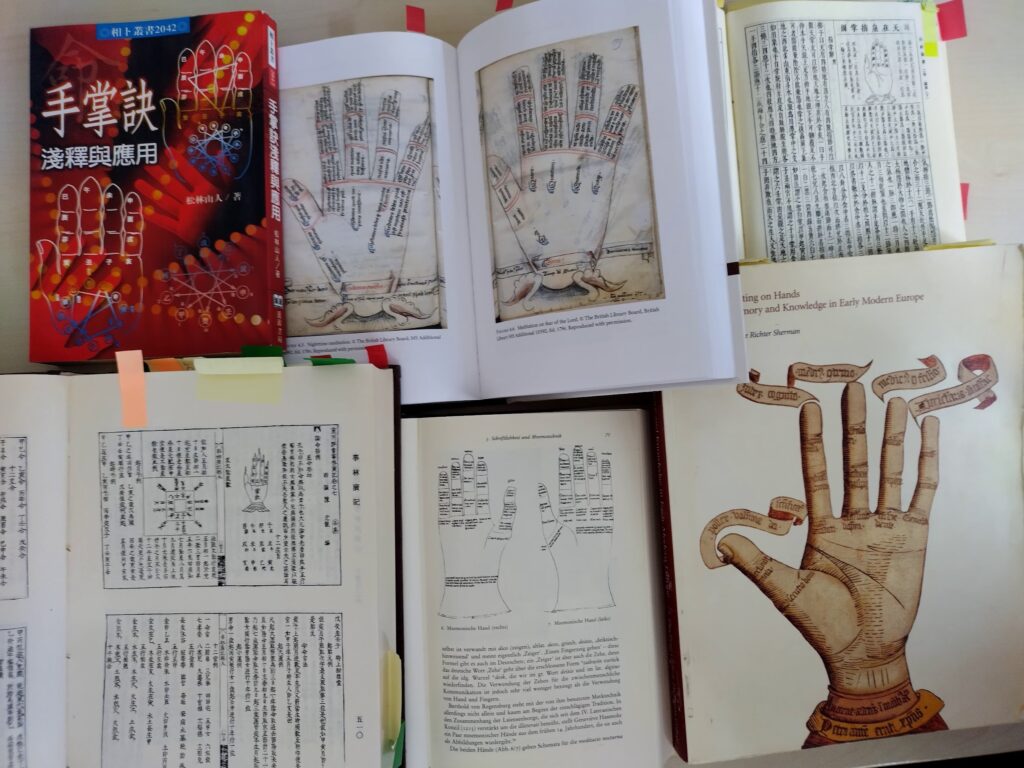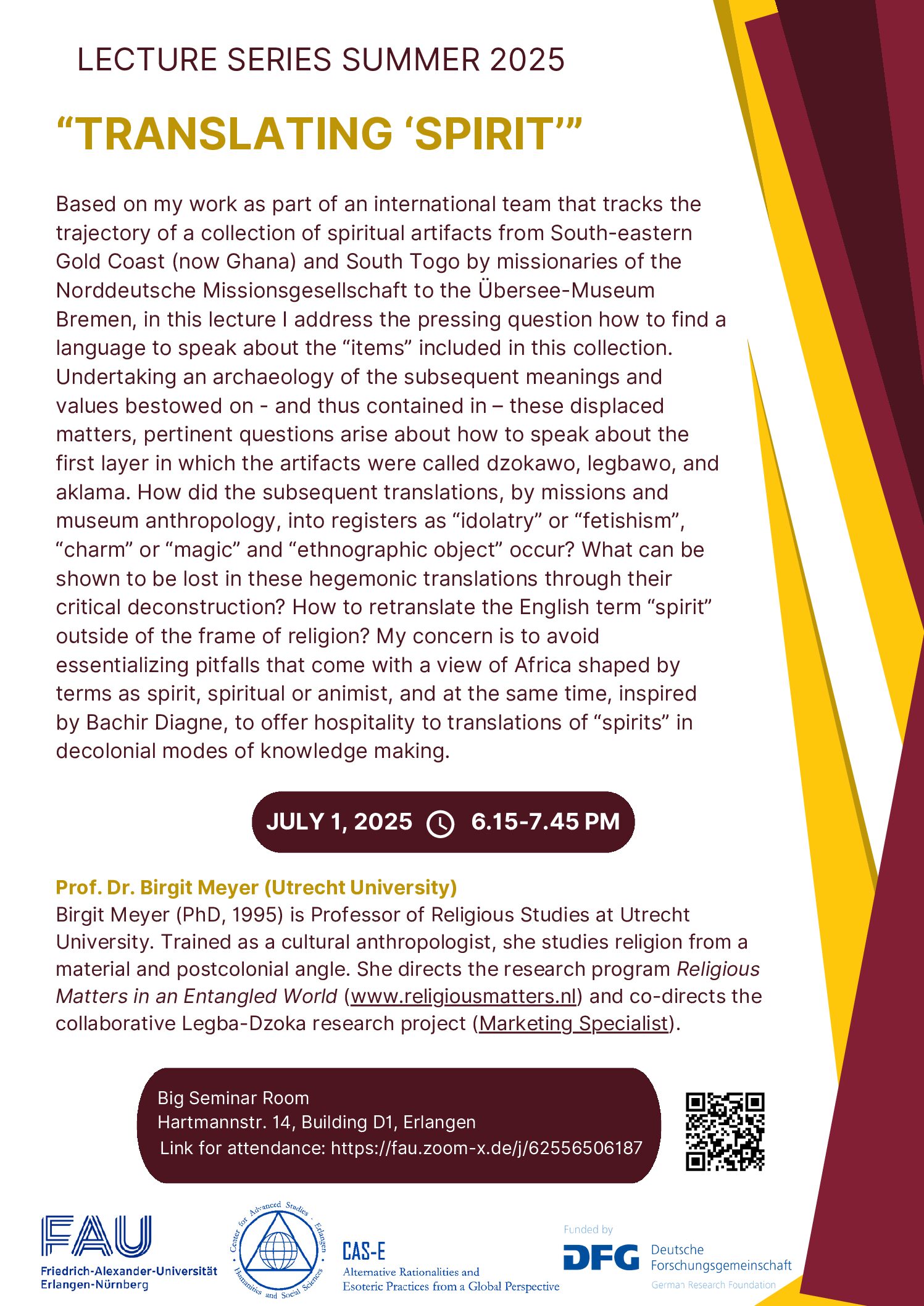Marta Hanson
The opportunity to speak on May 27th (2025) in the CAS-E summer semester lecture series, turned out to be a timely and appropriate milieu to introduce the “Knowing Hands” project.1 The Agence nationale de la recherche (ANR) and Deutsche Forschungsgemeinschaft (DFG) will jointly fund this project for three years (6.2025-5.2028). On the ANR side, my colleague anthropologist of Chinese divination Stéphanie Homola is based at CNRS in Paris. On the DFG side, I’m newly based at CAS-E in FAU Erlangen-Nürnberg. The lecture turned out to be a good on ramp to my new academic life at CAS-E and our joint efforts. In addition to insightful responses from people in the audience, the Knowing Hands project officially started just a few days later on June first.
What particularly interests us are examples of when people project concepts in their mind onto their fingers’ divisions as if they were cells in an excel spreadsheet for a wide range of reasons from mnemonic and divinatory to therapeutic and spiritual.2
We plan to explore hand-memory techniques in three ways: 1) in situ – historically and ethnographically in the Chinese world (focused on China but including spread to Japan, Korea, and Vietnam); 2) in comparison – mostly within the European tradition of arts of memory where it has been best studied but open to examples from any other place; and 3) in contact – through cross-cultural exchanges of European and Chinese hand-memory techniques.
Some illustrations of Chinese hand-memory techniques in situ start with the earliest 8th-c. Buddhist meditation hands3 and 11th c. medical prognostication hands extant in early 14th-c. printed medical texts.4 Many comparable methods continue to be used in every-day life in East Asia and online Sinosphere, especially for hand-based divination methods.5 These examples give a sense of the periodization and range of Chinese bodily arts of memory. Some of the books Stephanie and I are working with are illustrated in the image below (#1, 3, 6).

For comparison, in contrast to research on any kind of Chinese arts of memory, the literature on European arts of memory is extensive. Within that literature also exists important secondary scholarship on hand-memory techniques that people used in medieval and early modern Europe. One of the earliest European examples is that of the 12th-century Guidonian hand to teach the choral singers the solfège musical education system (i.e., when the syllables–do-re-mi-fa-so-la-ti–represent musical notes on a scale).
Since at least the 15th century there is evidence as well of five-finger-based Christian prayers. This practice persists today in Pope Francis’s Five-Finger Prayer found in Catholic children’s books12 and pamphlets one may well find for sale in the souvenir shops of Rome.13 Different examples of Latin Christian meditation hands are discussed in scholarship on medieval Christianity, some of which are illustrated in the scholarship depicted in the image above (#2, 4, 5).
The two in-contactexamples we know about to date are both related to Jesuit priests using hand-memory techniques to translate musical theory within early modern Sino-European exchanges. The first dates to the 1680s–90s when Portuguese Jesuit Tomás Pereira (1645–1708) translated the European Guidonian hand into Chinese for the Kangxi emperor (r. 1662–1722). The second dates to the 1780s when the French Jesuit Jean Joseph Marie Amiot (1718–1793) translated the Chinese hand mnemonic for 12–tone equal temperament into French in a book that introduced Chinese music theory to a European audience.
For the first year of the Knowing Hands project, we’re organizing an online exhibition and printed catalogue. Following the Comparative Guts model,14 we are working with German exhibition designer Christoph Geiger.15 Our goal is simple: readers can learn how to do each featured hand-memory technique by reading each entry’s images and related text, animation, and video. The Knowing Hands project is just getting going so there is still time to join our academic network and contribute your own scholarship on having one’s mind in hand.
#
Marta Hanson was Assistant Professor of late imperial Chinese history at the University of California, San Diego (1997-2004), Associate Professor of East Asian medical history in the History of Medicine Department, Johns Hopkins University (2004-2021), and is now a retired faculty member of The Academy at Johns Hopkins (2025-present). She was senior co-editor of the journal Asian Medicine: Tradition and Modernity (2011-2016), President of the International Society for the History of East Asian Science, Technology, and Medicine (ISHEASTM, 2015-2019), and is currently Vice President of the International Society for the Critical Study of Divination (2023-present). She is on the editorial boards of East Asian Science, Technology, and Medicine, East Asian Science, Technology, and Society, Asian Medicine, Chinese Medicine and Culture, Asian Journal of Medical Humanities, and International Journal of Divination and Prognostication.
____
CAS-E blogs may be reprinted with the following acknowledgment: “This article was published by CAS-E on July 22nd, 2025.”
The views and opinions expressed in blog posts and comments made in response to the blog posts are those of the author(s) and do not necessarily reflect the views and opinions of CAS-E, its founders, its staff, or any agent or institution affiliated with it, nor those of the institution(s) with which the author is affiliated.
- Interview with Michael Krauss of Friedrich-Alexander-Universität Erlangen-Nürnberg, Knowing Hands: Die Hand als Merkhilfe und Orakel, April 23, 2025. Accessed on June 19, 2025. ↩︎
- The CAS-E website introduced the Knowing Hands project with a collage of examples, January, 2025. Accessed on June 19, 2025. ↩︎
- Marta Hanson. 2017. “‘The Mysterious Names on the Hands & Fingers’: Healing Hand Mnemonics in Medieval Chinese Buddhism.” Chapter 47 in Buddhism and Healing in East Asia, 478-485. Edited by C. Pierce Salguero. New York: Columbia University Press. ↩︎
- Marta Hanson. 2008. “Hand Mnemonics in Classical Chinese Medicine: Texts, Earliest Images, and Artsof Memory.” Festschrift issue in honor of Nathan Sivin, Asia Major series 3, 21.1: 325-57. ↩︎
- Stéphanie Homola. 2014. “Les usages de la main dans les calculs divinatoires.” Etudes Chinoises, 33.1: 113-132; and 2015. “Ce que la main sait du destin: opérations et manipulations dans les pratiques divinatoires chinoises.” Ethnographiques.org 31. ↩︎
- Songlin shan ren 松林山人 (Man of Mount Pine Forest). 2010. Shouzhangjue qianshi yu ying yong 手掌訣淺釋與應用 (Brief Explanations and Applications of Palm Tricks). 2nd edition. Taipei: Jinyuan shuju. ↩︎
- Rice, Nicole R. 2023. The Medieval Hospital: Literary Culture and Community in England, 1350–1550. Notre Dame: University of Notre Dame Press. ↩︎
- Zhang Jiebin 張介賓 (1563-1640). 1624. Zhangshi Leijing 張氏類經 (Mr. Zhang’s Classified Canon), Zhangshi Leijing tuyi 張氏類經圖翼 (Mr Zhang’s Classified Canon, Illustrated Wing). 2nd edition. Taipei: Xinwenfeng chuban, 1994. ↩︎
- Claire Richter Sherman. 2000. Writing on Hands: Memory and Knowledge in Early Modern Europe, The Trout Gallery, distributed by the University of Washington Press. ↩︎
- Horst Wenzel. 1995. Hören und Sehen, Schrift und Bild: Kultur und Gedächtnis im Mittelalter (Hearing and Seeing, Writing and Images: Culture and Memory in the Middle Ages). Munich, Verlag C.H. Beck München. ↩︎
- Chen Yuanjing 陳元靚 (ca. late 13th c.-early 14th c.) Shilin guangji, [Zuantu zengxin leiju] [纂圖增新類聚] 事林廣記 (Broad-Ranging Record on Many Matters). Beijing: Zhonghua shuju chuban, 1999. Depicted page from 1699 Japanese edition. ↩︎
- https://www.catholicmom.com/articles/2015/04/27/praying-with-my-fingers-inspired-by-pope-francis
Accessed June 19, 2025. ↩︎ - https://www.zieglers.com/holy-card-pope-francis-five-finger-prayer-bchz5985/religious-articles/holy-cards/ Accessed June 19, 2025 ↩︎
- This online exhibition is our model: https://comparative-guts.net/ Accessed June 19, 2025. ↩︎
- See Geiger’s website for his wide-ranging work. https://www.christophgeiger.com/
Accessed June 19, 2025. ↩︎








